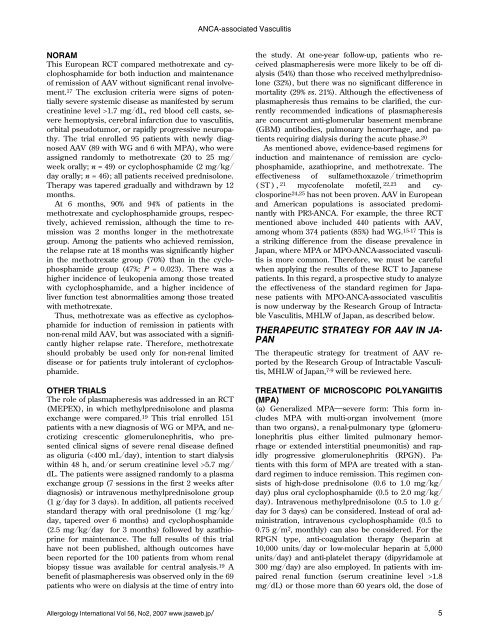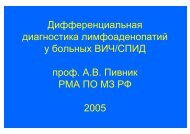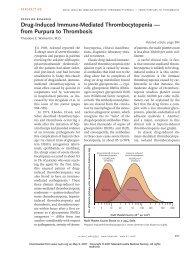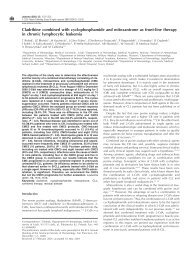ANCA-associated Vasculitis - Hem-aids.ru
ANCA-associated Vasculitis - Hem-aids.ru
ANCA-associated Vasculitis - Hem-aids.ru
Create successful ePaper yourself
Turn your PDF publications into a flip-book with our unique Google optimized e-Paper software.
<strong>ANCA</strong>-<strong>associated</strong> <strong>Vasculitis</strong><br />
NORAM<br />
This European RCT compared methotrexate and cyclophosphamide<br />
for both induction and maintenance<br />
of remission of AAV without significant renal involvement.<br />
17 The exclusion criteria were signs of potentially<br />
severe systemic disease as manifested by se<strong>ru</strong>m<br />
creatinine level >1.7 mgdL, red blood cell casts, severe<br />
hemoptysis, cerebral infarction due to vasculitis,<br />
orbital pseudotumor, or rapidly progressive neuropathy.<br />
The trial enrolled 95 patients with newly diagnosed<br />
AAV (89 with WG and 6 with MPA), who were<br />
assigned randomly to methotrexate (20 to 25 mg<br />
week orally; n = 49) or cyclophosphamide (2 mgkg<br />
day orally; n = 46); all patients received prednisolone.<br />
Therapy was tapered gradually and withdrawn by 12<br />
months.<br />
At 6 months, 90% and 94% of patients in the<br />
methotrexate and cyclophosphamide groups, respectively,<br />
achieved remission, although the time to remission<br />
was 2 months longer in the methotrexate<br />
group. Among the patients who achieved remission,<br />
the relapse rate at 18 months was significantly higher<br />
in the methotrexate group (70%) than in the cyclophosphamide<br />
group (47%; P = 0.023). There was a<br />
higher incidence of leukopenia among those treated<br />
with cyclophosphamide, and a higher incidence of<br />
liver function test abnormalities among those treated<br />
with methotrexate.<br />
Thus, methotrexate was as effective as cyclophosphamide<br />
for induction of remission in patients with<br />
non-renal mild AAV, but was <strong>associated</strong> with a significantly<br />
higher relapse rate. Therefore, methotrexate<br />
should probably be used only for non-renal limited<br />
disease or for patients t<strong>ru</strong>ly intolerant of cyclophosphamide.<br />
OTHER TRIALS<br />
The role of plasmapheresis was addressed in an RCT<br />
(MEPEX), in which methylprednisolone and plasma<br />
exchange were compared. 19 This trial enrolled 151<br />
patients with a new diagnosis of WG or MPA, and necrotizing<br />
crescentic glome<strong>ru</strong>lonephritis, who presented<br />
clinical signs of severe renal disease defined<br />
as oliguria (5.7 mg<br />
dL. The patients were assigned randomly to a plasma<br />
exchange group (7 sessions in the first 2 weeks after<br />
diagnosis) or intravenous methylprednisolone group<br />
(1 gday for 3 days). In addition, all patients received<br />
standard therapy with oral prednisolone (1 mgkg<br />
day, tapered over 6 months) and cyclophosphamide<br />
(2.5 mgkgday for 3 months) followed by azathioprine<br />
for maintenance. The full results of this trial<br />
have not been published, although outcomes have<br />
been reported for the 100 patients from whom renal<br />
biopsy tissue was available for central analysis. 19 A<br />
benefit of plasmapheresis was observed only in the 69<br />
patients who were on dialysis at the time of entry into<br />
the study. At one-year follow-up, patients who received<br />
plasmapheresis were more likely to be off dialysis<br />
(54%) than those who received methylprednisolone<br />
(32%), but there was no significant difference in<br />
mortality (29% vs. 21%). Although the effectiveness of<br />
plasmapheresis thus remains to be clarified, the currently<br />
recommended indications of plasmapheresis<br />
are concurrent anti-glome<strong>ru</strong>lar basement membrane<br />
(GBM) antibodies, pulmonary hemorrhage, and patients<br />
requiring dialysis during the acute phase. 20<br />
As mentioned above, evidence-based regimens for<br />
induction and maintenance of remission are cyclophosphamide,<br />
azathioprine, and methotrexate. The<br />
effectiveness of sulfamethoxazole trimethoprim<br />
(ST), 21 mycofenolate mofetil, 22,23 and cyclosporine<br />
24,25 has not been proven. AAV in European<br />
and American populations is <strong>associated</strong> predominantly<br />
with PR3-<strong>ANCA</strong>. For example, the three RCT<br />
mentioned above included 440 patients with AAV,<br />
among whom 374 patients (85%) had WG. 15-17 This is<br />
a striking difference from the disease prevalence in<br />
Japan, where MPA or MPO-<strong>ANCA</strong>-<strong>associated</strong> vasculitis<br />
is more common. Therefore, we must be careful<br />
when applying the results of these RCT to Japanese<br />
patients. In this regard, a prospective study to analyze<br />
the effectiveness of the standard regimen for Japanese<br />
patients with MPO-<strong>ANCA</strong>-<strong>associated</strong> vasculitis<br />
is now underway by the Research Group of Intractable<br />
<strong>Vasculitis</strong>, MHLW of Japan, as described below.<br />
THERAPEUTIC STRATEGY FOR AAV IN JA-<br />
PAN<br />
The therapeutic strategy for treatment of AAV reported<br />
by the Research Group of Intractable <strong>Vasculitis</strong>,<br />
MHLW of Japan, 7-9 will be reviewed here.<br />
TREATMENT OF MICROSCOPIC POLYANGIITIS<br />
(MPA)<br />
(a) Generalized MPAsevere form: This form includes<br />
MPA with multi-organ involvement (more<br />
than two organs), a renal-pulmonary type (glome<strong>ru</strong>lonephritis<br />
plus either limited pulmonary hemorrhage<br />
or extended interstitial pneumonitis) and rapidly<br />
progressive glome<strong>ru</strong>lonephritis (RPGN). Patients<br />
with this form of MPA are treated with a standard<br />
regimen to induce remission. This regimen consists<br />
of high-dose prednisolone (0.6 to 1.0 mgkg<br />
day) plus oral cyclophosphamide (0.5 to 2.0 mgkg<br />
day). Intravenous methylprednisolone (0.5 to 1.0 g<br />
day for 3 days) can be considered. Instead of oral administration,<br />
intravenous cyclophosphamide (0.5 to<br />
0.75 gm 2 , monthly) can also be considered. For the<br />
RPGN type, anti-coagulation therapy (heparin at<br />
10,000 unitsday or low-molecular heparin at 5,000<br />
unitsday) and anti-platelet therapy (dipyridamole at<br />
300 mgday) are also employed. In patients with impaired<br />
renal function (se<strong>ru</strong>m creatinine level >1.8<br />
mgdL) or those more than 60 years old, the dose of<br />
Allergology International Vol 56, No2, 2007 www.jsaweb.jp 5







